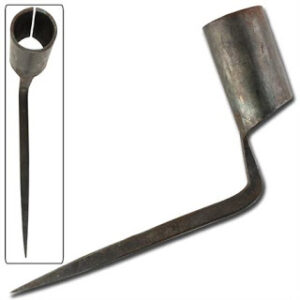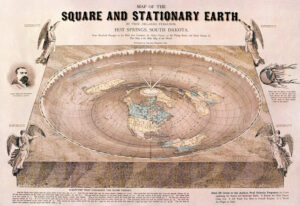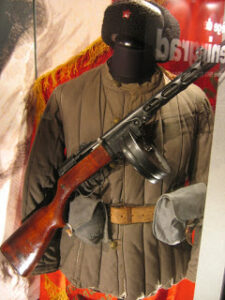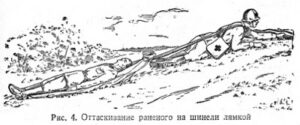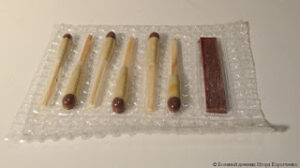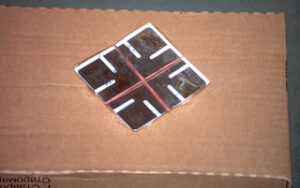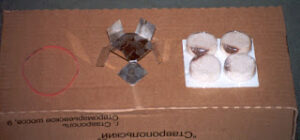Once, while I was in Saltzberg, an American lad asked me to pass him his daysac. It nearly wrenched my arm from its socket with the unexpected weight.
“This is heavier than my entire kit!” I complained “What have you got in here?”
“Just my gel and moose and shampoo and conditioner and…”
You get the idea!
Choice of wash kit is personal, but I'll describe mine as a guide.
Like many travelers, I used to use a washroll or zippered bag for my wash kit.
The last one I used was quite an ingenious in that it had lots of pockets and compartments, a hook it could be hung up by and a little mirror that attached to a pad of Velcro.
One day it occurred to me just how much unnecessary bulk and weight all those thicknesses of condura contributed.
Now I just use a mesh drawcord bag.
I can hang the bag from the cord, or knot the cord around a pipe if there is nothing to hook it over.

Contents:
- A screw topped plastic bottle of shampoo. I use a 50 ml plastic screw-topped tube. I’ve taken trips of a month or more and never managed to use up all this shampoo. Older I get, the less hair that needs washing!
- A flannel, though half of one will do. Always give this a good wringing out before packing away. In actuality I seldom use a flannel, so this is an item that could be omitted. I mainly use mine for scrubbing stains on clothing. My old cotton flannel seems to have survived the decades, but you might like to consider the more recent microfibre face cloths if you are creating your own new kit.
- A bar of soap. Soap can be used as an antiseptic, laundry agent and for shaving. Hence I have no need to carry a shaving brush nor foam. Many of the soap cases available in the shops are made of too brittle a plastic and therefore are of little use for travelling. Nowadays I keep the bar of soap in a small PU nylon drawcord bag, which is simpler and lighter. Unlike most soap cases, I can hang the bag up in the shower. Making such a bag should be within anyone's sewing skills. The soap bag often ends up outside the mesh bag so the soap can dry. A full bar of soap is probably unnecessary. Half a bar is more than enough for most trips.
- A disposable razor or two, depending on the length of the trip. I have a beard these days but still pack a couple of razors to keep the stubble down on my neck and throat.

- One of the most useful things I've carried on my travels is a little nail brush, just an inch or so long and brought for a few pence in a supermarket or cosmetics shop. I think my second one was from Body Shop. I don't think I've ever used it for my nails. What it has been used for includes:
- Brushing dried mud off my canvas and suede summer boots: a lot easier than washing them and scrounging newspaper to pack in them to dry.
- Using with hand soap to scrub away collar grime or food stains. Laundry is then simply done in a wash basin or shower, for free!
- Brushing dried mud out of clothes. One of the most popular clubs with travellers in Jerusalem has a floor not unlike a farmyard. Every morning in the hostel my little brush would pass through a score of hands as garments were restored to a more presentable condition. So appreciated was this item that someone stole it from me!
- A “fit anyhole” sink plug. You often encounter sinks without plugs. This is such a useful item I have had them stolen from me by other travellers. I have seldom used it myself. Shaving and washing under a running tap, and turning the tap off when not needed uses less water and is actually simpler, so I would not replace this if it was lost or perished.

- A small mirror. The one that came with the wash roll broke, being glass. My current one is made from a piece of polished door finger plate, brought from a hardware store. Acrylic camping mirrors are an alternative. Shop around since price varies considerably for what is essentially the same thing. Add a short length of fishing line or rot-proof cord so you can hang it up or tie it around something. Mine also has a blob of blu tac on the back.
- A spare comb.
- A packet of dental floss. I have mainly used this as heavy thread for repairs. If you look at my self-built rucksac you can spot some dental floss repairs!
- A couple of moist napkins in foil packets. These are used to freshen up when washing is not possible.
These are the contents of my mesh bag. There are a couple of associated items, several of which can be found in the same rucksack pocket.
For a very long trip I might consider taking my electric beard trimmer. This fits in a pencil case with its attachments, cleaning brush and oil.
An associated item I always carry is a mesh pencil case holding a toothbrush, toothpaste and deodorant. I found that I tended to need these items at different times to the rest of the wash kit, so it was handier to have them separate in a side pocket of the rucksack. This was probably a more logical place to carry the dental floss, so I moved it to here.

- Deodorant/Antiperspirant. I generally use gels or soft sticks. These are a lot less bulky than aerosols and probably last longer.
- A toothbrush and paste. You can get folding travel models of toothbrush, but I just use a normal one. I intend to replace this with a child-size brush.
Towels
Also with the wash kits is a travel towel.
Travel towels made from Pertex are not only small packing but dry very rapidly. I think I acquired my actual towel on a trip. It seems to be made from something like polyester. Not as fast drying as Pertex, I expect, but still quicker and less bulky than cotton.
There are other options if you cannot get a towel of high-tech modern material .
In the article on ninja rokugu, we encountered the tenugui. Towels do not need to be the big fluffy things you use at home.
Tenugui are unhemmed, supposedly making them easier to wring out. Thin cloth and frayed edges make it quicker drying.
Put another way, anyone with some thin cotton or linen can make themselves a travelling tenugui. You probably have an old shirt, pillowcase or bedsheet you can re-purpose.
Wikipedia says a tenugui is 35 by 90 cm, but for a travelling item you can shave a few centimetres off either of these dimensions in interests of packability.
A thin cloth such as a bandanna, tea-towel or shemagh can be used instead.
Whatever your choice of travel towel, add a loop of cord, ribbon or string to your towel and make the loop big enough to pass the towel through or to knot around something. This lets you attach the towel to a rucksac hand-loop or strap to dry in the breeze.
If a low profile is desired, use a neutral or natural coloured cloth.
In addition to these items, my daysac has a toilet roll and hand-sanitizer in a plastic bag.
You can improvise to overcome the loss of several of these items.
Soap is mainly a lubricant so a lot of the dirt can be removed with just water and more scrubbing. In the past sand or oils have been used, and certain leaves, grass or straw may make good scrubbers.
In cold dry conditions you can wash yourself with handfuls of snow. Snow is very absorbent so can be used to dry you but should not be kept on the skin too long. It is cold so you wouldn't want to do this!
Salt has been used in place of toothpaste but in fact it is the mechanical action of brushing that is more important for cleaning. Using a fingertip is well known but chewing a stick and using the frayed end is more effective.
Some hikers clean their teeth with baking soda or a mix of baking soda and salt. Apparently this does not attract bears like flavoured toothpaste can.
Plug holes can be plugged with blobs of toilet paper.
Splashing around in a river can be great fun but it’s better you carry some water away to wash with.
Your soap may be biodegradable but before it degrades it's still contaminating a water supply and many creatures' environment.
Better to pour it on the soil where the organisms there can degrade it more usefully.
And That Is a Good Way Too!
An idea I have recently encountered is to carry your wash kit in something such as a plastic sandwich or ice cream box. The mirror may be attached to the inside of the lid (I suggest blu tac).
I added an adhesive backed piece of mirrored plastic to the inside of the box lid. Not the best mirror in the world, but quite good for signalling, since it is bigger than those I carry as heliographs.
The advantage of this approach is that the bottom of the box may be used as a water bowl, should you need one.
It also provides a little more protection to your wash kit should it be rattling around in the main compartment rather than in its own side pocket.
A potential problem is that a box may keep your items from drying out, which may be undesirable under certain conditions. If this proves to be the case, consider adding some ventilation holes to the lid.
A cord run through a pair of holes could be used to hang-up the lid and mirror.
Best of both worlds would be to find a box that will hold your mesh bag.
If you are travelling very light or expect accommodations that will not need you to provide your own bowl, take just the mesh bag.
If living a little rougher, carry your mesh bag in the box.

